Saltwater pools are gaining popularity because of their low maintenance costs and health benefits. If you have a standard pool, you may wonder if you can convert it to saltwater. The short answer is yes, you can, and it’s easier than you think.
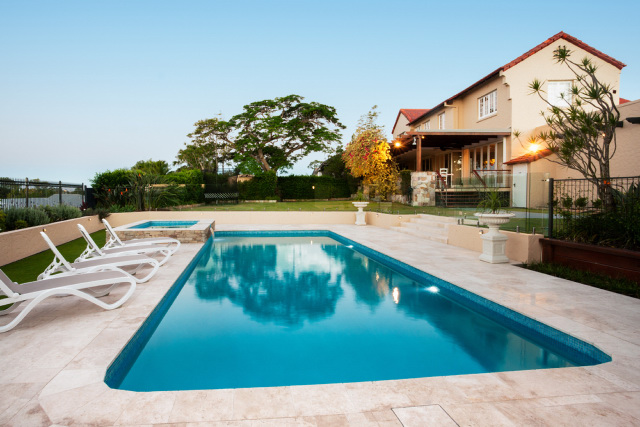
Article Contents
Can You Convert a Pool to Saltwater?
Any pool, whether above ground or inground, can be converted to a saltwater pool in just a few simple steps and is more cost-efficient than many think. Converting a pool to saltwater really boils down to installing a salt generator into your plumbing line.
The salt generator consists of a board and a cell. The board is the information panel, and the cell converts salt into chlorine through electrolysis. So, just like chlorine is a synthetic sanitizer for your pool, the salt cell produces sanitizer through natural means.
Pros & Cons of Converting to Salt
If you’re undecided about switching to saltwater, here are the pros and cons. I think a saltwater pool is the best choice for many reasons. There are some minor drawbacks, but the pros far outweigh the cons.
Pros:
- Healthier
Saline is much healthier on your skin and hair than chlorine, especially if the pool is over-chlorinated.
- Saltwater pools are easier to maintain
A salt generator takes the guesswork out of sanitizing your pool, which contributes to keeping your pool from turning green. Just keep an eye on the salt generator board, especially when installing it, to ensure the saline is in the proper range.
- Cheaper in the short term
Generally, saltwater pools have fewer annual maintenance costs than chlorinated pools. The price of chlorine alone will make up for the cost of converting to saltwater, and salt is less than a dollar per pound.
- No smells
A chlorinated pool can put off a strong chlorine smell. Salt has no smell and you don’t have to wait to swim after the generator sanitizes the pool.
Cons:
- Salt generators are expensive
Although there are more affordable options, saltwater generators cost over $1,000. However, they usually last for years, and most come with a warranty. Still, this is a small price to pay in terms of convenience and the price savings of not having to buy chlorine on a regular basis.
- Metal parts can corrode
If you have a lot of metal parts in your pool, you may want to consider getting a professional opinion before converting to saltwater. The existing metal could rust, especially if it has some age.
How Much Does a Conversion to Saltwater a Pool Cost?

Converting to a saltwater pool costs an average of $1,500-$2,500, depending on what salt generator you purchase. As I stated earlier, most models cost above $1,000, but there are also cheaper models.
You can get a decent model for around $800-$900, but you may want to budget around $1,200 to be safe. You will also need to purchase salt for the initial sanitizing. Saltwater pools require 200 pounds of salt per 10,000 gallons of water. After the initial treatment, you only need a bag or two every few weeks under normal operating conditions. Rainy seasons or unusual heat dilute chlorine faster, and you may need to add more salt than usual.
Is It Hard to Convert a Pool to Saltwater?
Converting a saltwater pool is surprisingly easy. You can do the job in about an hour if you’re a handy person and own a few hand tools.
All you really need to do is add salt to the pool, install the salt cell (cut the return line after the filter and glue it in), mount the control panel and supply power to it.
Choosing a Saltwater Generator
Researching which salt generator you want will probably take longer than installing the generator.
When choosing a salt generator, you should consider the following three factors. After you have settled on the one you want, installation is easy, with just a few steps.
- Size. Choose a size that is designed for your pool capacity in gallons. Each manufacturer will mention the capacity the salt cell is best suited to.
- Price. You should choose the highest quality salt generator you can afford.
- Features. Salt generators come with a wide array of features like WiFi, battery backup, self cleaning and more. Some models have simple LED lights to indicate status. Higher end models will have an LCD display so you can monitor various functions like voltage, waterflow, power level, timer, salt level and more. Choose one that fits your budget but also provides the necessary information that you want on the board.
Materials/Equipment Needed to Convert to a Saltwater Pool
Remember when installing the salt generator that you will be working with electricity in a wet environment, so proceed cautiously. Turn off the power at the breaker box to ensure no electrical current flows through the pump system where you are working.
You will need a few hand tools like PVC cutters, wire strippers, a Phillips screwdriver, and PVC glue. I also recommend a volt tester to ensure the power is completely cut off before starting. It is also a wise idea to mark the breaker box with a tag that says the breaker needs to stay off or put some tape over it so.
Salt
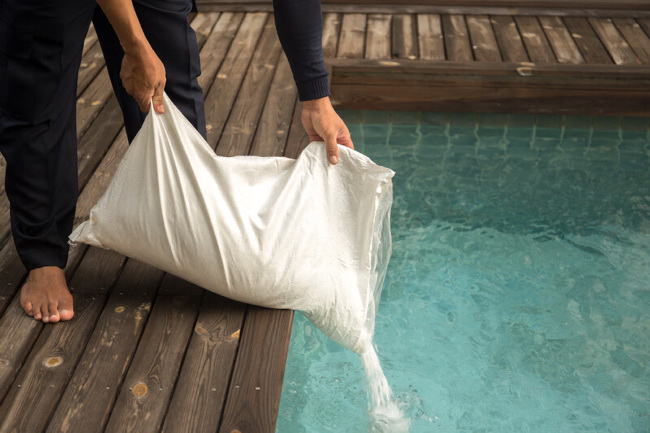
Before installing the salt generator, you must add 200 pounds of salt per 10,000 gallons of pool water. That’s about 5 bags of salt (40 lbs per bag).
Saltwater Chlorinator Control Module
The saltwater chlorine generator (SWG) control module is the command center for the salt cell and will be mounted on the wall near the pool pump. The module is designed to regulate how much chlorine the salt cell generates and is powered by the same circuit as your pool pump. Control modules are universal, so it doesn’t have to be the same manufacturer as your current equipment.
Salt Generator Cell
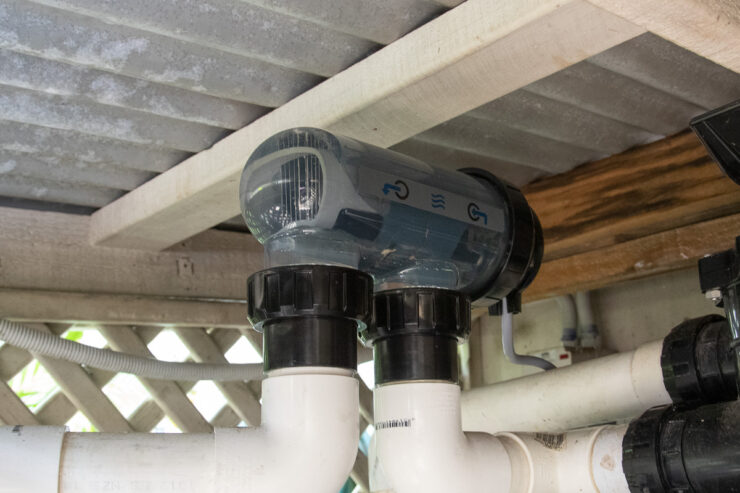
The salt generator will be the last piece of equipment you install, and it will be installed directly into the return line that comes from the pump and returns to the pool. Salt cells contain rare-earth materials that last, on average, 4-5 years. To get the best return on your investment, purchase an oversized cell.
Water Sensor/Flow Switch
Salt systems need to be able to detect that water is present inside of them. These are generally plumbed inside the unit but can also be plumbed into the outside of the cell. These are extremely helpful if you have a variable speed pump with its detection system, as your cell has an independent system.
How to Convert to a Saltwater Pool
Now that you know you can convert your pool to saltwater with a few easy steps, the question is, what salt generator should I purchase? That depends on the factors listed above, but here are some recommendations.
- Hayward Aquarite. I have installed many of these, and the pool owners have been satisfied. It’s a reliable system, and the upkeep is easy.
- Pentair Intellichlor. I see this is the most common unit when I do routine maintenance on swimming pools. It’s a reliable system with a decent warranty.
You can get these products here:
| Image | Product | Features | Link |
|---|---|---|---|
 | Hayward Salt Chlorination System
| 9.7 | Check Price |
 | Pentair Salt Chlorine Generator
| 9.5 | Check Price |
Step 1: Balance the pool chemicals
Test and balance the chemicals as you do weekly.
Step 2: Add the required salt to the pool
Add 200 pounds of salt per 10,000 gallons of water. Evenly distribute the salt around the pool and brush the walls and floor afterward to break up any residual clumps. The salt will slowly distribute and dissolve. Unlike liquid chlorine, it may take up to 24 hours to dissolve.
Different saltwater generators require different levels of salt, so check the manufacturer’s instructions when adding the salt and test the salt levels in the water.
Step 3: Mount the chlorinator control housing
The housing will be mounted at your pump station near the timer. Mount it in a safe (where it is away from water and kept dry) and convenient location for easier accessibility.
Step 4: Wire the chlorinator control housing
Some units come with a power cord designated for a GFCI-protected power outlet. Other models can be wired into your timer or pool pump. I would recommend you use an electrician for this step.
Either way, you want it on the same timer as your pump, so the salt generator only turns on when the pump is on.
Step 5: Install the salt cell
The salt generator cell needs to be installed last. You will install it into the plumbing line after the filter. The cell comes with a cutting template to make it easier. Always check that the cord length reaches the outlet before cutting the pipe. And remember you’ll need to use PVC pipe glue on the pipes to ensure a watertight seal.
After installation, connect the generator cord to the control housing.
Step 6: Turn the system back on
Turn your pool system on and carefully look for any leaks. Run the system for at least 8 hours to distribute the salt evenly around the pool. Check the new salt system for leaks or electrical issues during this time. Keep an eye on the saltwater chlorinator control panel for warning lights. If the salt hasn’t dissolved when you switch the system on, you may get a low salt warning light. It will go away once the salt has fully dissolved.
Is it Cheaper to Run a Saltwater Pool?
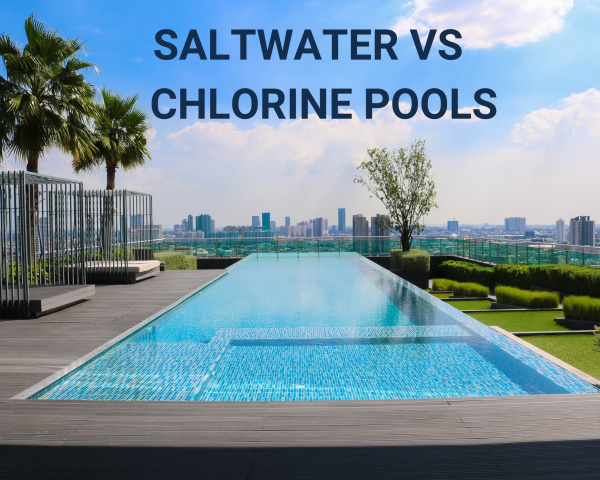
We have a full article detailing saltwater vs chlorine pool costs. Here’s a quick summary.
For routine maintenance, a saltwater pool is cheaper than a chlorinated pool. The reason is that salt is cheaper than chlorine. Currently, the average price for 2.5 gallons of chlorine is $8.00, and the average price of fine (pool) salt is $0.63 per pound and is sold in 40-pound bags (about $25 per bag).
You’ll likely need 1-2 gallons per week of chlorine for a 10-15K gallon pool. And for salt, you’ll need around 2-5 bags per year, plus additionally, you’ll need to add a little more muriatic acid to keep the pH down. pH tends to rise in a salt pool.
The initial cost of converting to saltwater is a little pricey, depending on the generator you get. But, the savings on chlorine will pay for itself. I also find that saltwater pools don’t turn green nearly as fast as chlorinated pools, which is a huge saving. Green pools can easily cost $80 in chemicals to clear them.
How Does a Saltwater Pool Work?
A saltwater pool sanitizes with chlorine in a different way than liquid or granular chlorine. Salt generators convert the sodium chloride (table salt) in the pool water into chlorine through electrolysis. The process converts the salt into sodium hypochlorite and hypochlorous acid, producing sanitizing, oxidizing, and disinfecting agents.
Saltwater Pool Maintenance Requirements
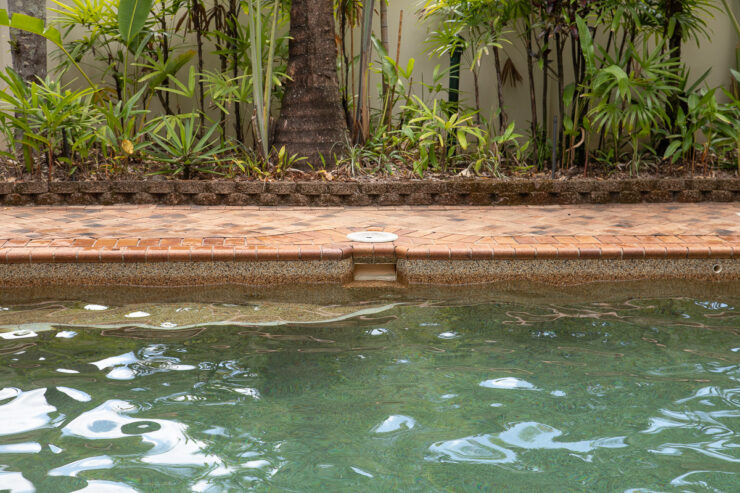
Here’s a quick comparison for the maintenance requirements for a saltwater vs a chlorine pool:
| Task | Saltwater Pool | Chlorine Pool |
| Test Salt Level | Yes | n/a |
| Add Salt | 1-2 times per season | n/a |
| Clean Salt Cell | Every 3-4 months | n/a |
| Add Chlorine | n/a | 2-3 times per week |
| Water Testing | 1-2 times per week | 1-2 times per week |
| Chemical balancing | Weekly or as needed | Weekly or as needed |
| Cleaning | Weekly or as needed | Weekly or as needed |
Saltwater pools require the same maintenance as chlorinated pools. The advantage is that you won’t have to buy chlorine every week or spend time adding it, and the salt cell has lights to inform you of your salt level and if any additional salt is needed. Some models even come with a phone app.
Perform your regular maintenance duties as usual: weekly water testing and balancing, clean the skimmer and pump baskets weekly, clean the filter monthly, and run your system for at least 6 hours daily. The only other maintenance task is to clean the salt cell every three months with a muriatic bath to prevent the scale from forming.
Check to see if the salt cell lights are green whenever you do your weekly maintenance on the pool. If not, there is a water flow issue. More times than not, I find that the cause of this is the skimmer basket O-ring. If they stretch out even a little, the water flow decreases, and the cell won’t work as a safety precaution. Just replace the O-ring and always put lubrication on it before reinstalling it.
Do You Need to Drain to Convert to Saltwater?
You do not need to drain your pool before converting to a saltwater system. Just make sure to balance the chemicals before and after installation. However, suppose you currently have an antibacterial agent (like biguanide) in your pool. In that case, you may want to consider draining most, if not all, of the water before installing a salt generator.
This is because the chemical agent in antibacterial sanitizers is polyhexamethylene biguanide, which is incompatible with salt. If this agent is present in your pool and you add salt as a sanitizer, it will be hard to balance the chemicals, and the salt will not be as effective.
Final Thoughts: Is It Worth Converting a Pool to Saltwater?
As a pool professional, I highly recommend converting your pool to a saltwater system. I maintain hundreds of pools a week, and the easiest pools to maintain are saltwater. The upfront costs may seem exorbitant, but if you compare that price to your annual maintenance costs, the savings become clear.
The average salt cell lasts 4-5 years before it needs to be replaced. For other issues, there are plenty of troubleshooting tips to resolve most things, and maintenance costs are not too bad. The best thing you can do is clean the salt cell with a muriatic acid wash every three months to ensure sodium and scale do not build up on the inside.
It’s not only less expensive to convert a pool to saltwater in the short run, but it is also healthier for the pool and its occupants. Chlorine can adversely affect our skin, hair, and possibly the respiratory system if there is too much chlorine in the pool.
For many people, the feel of a saltwater pool is what they love about them. The water feels silkier and just nicer.
A saltwater pool is like using bromine instead of chlorine in your hot tub. It’s an effective sanitizer without the harshness of chlorine. Using salt instead of chlorine is also healthier for the environment.
Another big advantage of a saltwater pool system is that you don’t have to add chlorine. You will need to add salt occasionally, but under normal circumstances, it’s minimal. Keep a couple of bags of salt near your pump station, and when the need arises, add the required amount to the deep end and brush afterward to ensure it dissolves.

